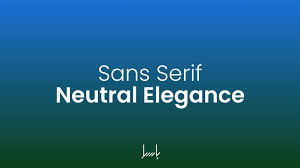In the realm of typography, the choice of font can significantly affect the readability, aesthetics, and overall impact of a design. Among the myriad of font styles available, sans serif fonts have carved out a prominent niche. Characterized by their clean lines and lack of decorative flourishes, sans serif fonts are celebrated for their modern, straightforward appearance. This blog post delves into the history, characteristics, uses, and benefits of sans serif fonts, exploring why they have become a staple in contemporary design.
Early Beginnings
The first sans serif fonts appeared in the late 18th century, but they were initially met with resistance and skepticism. In 1786, a typeface without serifs appeared in a book by William Caslon IV, though it was not widely adopted. The first commercial sans serif typeface was introduced by William Caslon IV in 1816, but it wasn’t until the 20th century that sans serif fonts gained significant popularity.
The 20th Century and Modernism
The rise of modernism in the early 20th century brought about a shift in design preferences. Modernist designers favored clean, functional, and unadorned aesthetics, which aligned perfectly with the characteristics of sans serif fonts. Typeface designers like Paul Renner, who created Futura in 1927, and Max Miedinger, the designer of Helvetica in 1957, played pivotal roles in popularizing sans serif fonts.
The Digital Age
The advent of digital technology and the internet further cemented the popularity of sans serif fonts. Their readability on screens, coupled with their modern and minimalist appeal, made them the go-to choice for web and user interface design. Fonts like Arial and Verdana became ubiquitous in digital media, solidifying the dominance of sans serif fonts in the digital age.
Characteristics of Sans Serif Fonts
Sans serif fonts are defined by their lack of serifs, but they possess several other characteristics that make them distinct and versatile:
- Clean Lines: Sans serif fonts have clean, straight lines without any embellishments, contributing to a modern and uncluttered appearance.
- Uniform Stroke Width: The stroke width in sans serif fonts is usually more uniform compared to serif fonts, which often have varying stroke widths.
- Legibility: The simplicity and clarity of sans serif fonts enhance legibility, especially at smaller sizes and on digital screens.
- Versatility: Sans serif fonts can be used in various contexts, from body text to headlines, and are suitable for both print and digital media.
Types of Sans Serif Fonts
Sans serif fonts can be further categorized into different types based on their design characteristics:
- Grotesque Sans Serifs: These are the earliest sans serif fonts, characterized by their slightly crude and irregular shapes. Examples include Akzidenz-Grotesk and Franklin Gothic.
- Neo-Grotesque Sans Serifs: Developed in the mid-20th century, these fonts have a more refined and neutral appearance. Helvetica and Univers are notable examples.
- Humanist Sans Serifs: These fonts are inspired by traditional calligraphy and have more organic, varied stroke widths. Examples include Gill Sans and Frutiger.
- Geometric Sans Serifs: Based on geometric shapes, these fonts have a clean and modern appearance. Futura and Avenir are popular geometric sans serif fonts.

